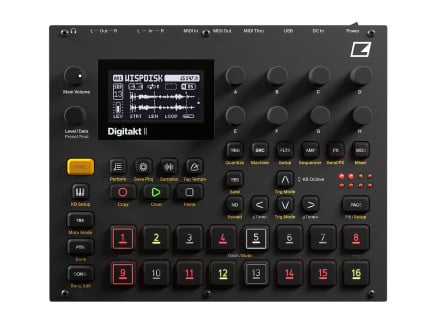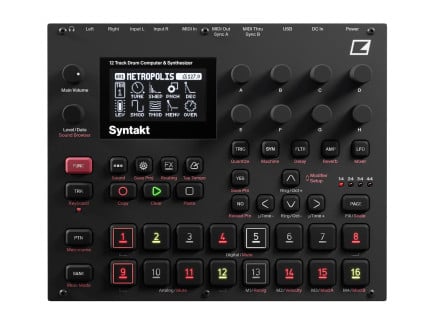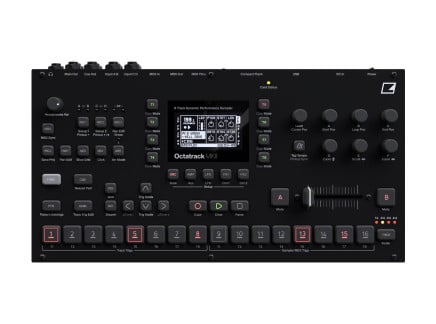The rumors are true: today, Elektron announces the newest member of their Digi series lineup—the Digitakt II. Taking their modern classic all-in-one sampling workstation into new territory, Digitakt II bears close resemblance to its predecessor. However, clearly designed with a "more is more" philosophy at its core, Digitakt II is, in many ways, twice the instrument of its forebear—and more.
Being one of the most popular manufacturers of electronic music gear, we've discussed Elektron extensively in the past—perhaps most directly in our article Which Elektron Box is Right for You? In this epic overview of the brand as a whole, we touch on Elektron's history, design philosophy, and high-level concepts found throughout their instruments. Taking a closer look, we can see that Elektron's overall product line is, at the current time, broken into three high-level categories: the flagship Octatrack, Analog Four, and Analog RYTM on one tier; the mid-range Syntakt, Digitakt, and Digitone in the middle; and the model:samples and model:cycles on the entry-level, extremely user- and budget-friendly tier.
The thing is—as time has gone on, that "middle tier" has become more and more powerful. Given Elektron's overall level of flexibility and musical sophistication, even their most budget-friendly products offer capabilities uncommon in their own price range. And indeed, while the Octatrack, A4, and RYTM do offer their own self-contained universes with distinct musical logic, their little siblings—namely, Digitakt, Syntakt, and Digitone—have become downright ubiquitous. Though it's easy to think of them as "middle of the road" options, they're still deeply flexible machines. As such, they've become the very center of many musicians' workflows, and over time, each one has begun to develop its own unique musical vocabulary and techniques.
Today, Digitakt in particular gets a significant upgrade...and no doubt, over time, we'll see that its potential uses are expanding considerably. The new Digitakt II takes a critical look at the original's shortcomings and the creative workarounds that musicians have begun to employ to reach specific end goals. Many of the updates might seem like simple quality of life changes, but users of the original Digitakt will quickly realize that these updates have profound creative implications. Likewise, it introduces a number of all-new features aimed at new methods of sampling and control. So, let's take a quick, high-level look at what's new with Digitakt II.
Elektron Digitakt II Overview
Taking a quick look at Digitakt II, you'll first notice that it looks...very similar to the original. Players of the original should be instantly at home with the new version's control layout and approach to visual feedback, but they'll also quickly find that its expanded capabilities open up new musical opportunities altogether. As always, Digitakt II allows for easy sampling of external sound sources, be it from the analog audio inputs, internal resampling, or by streaming audio from a connected USB source. Sample editing is as easy as ever, with the parameterization and precision required for executing the most meticulous of edits with ease.
So, what is new with Digitakt II? Let's hit some of those quality of life changes first, as we suspect they'll squash a number of long-time public gripes about the Digitakt's general capabilities. Let's talk basic stats: the original Digitakt had eight tracks of mono sampling, but Digitakt II goes double in both respects, with sixteen stereo tracks. Any of the sixteen tracks may be used as a MIDI track—instead of a max of 64 sequence steps, you get 128 sequence steps. In those respects, Digitakt II does seem to be, well, twice the instrument of the original.
Then there are the specs that are more than double those of the original. The original had one gigabyte of onboard sample storage; Digitakt II has 20GB of internal storage (yep, you read that correctly). The 64MB of sample RAM has been expanded to 400MB; the prior 128 sample-per-project restriction has been expanded to a whopping 1024 samples per project.
But the changes in Digitakt II aren't just about its admittedly beefy specs—there are tons of new features altogether. You get access to several distinct "machines"—including concepts first introduced in later firmwares for the original Digitakt—including "SRC" machines which each offer different approaches to sampling and sound manipulation. The Oneshot machine is the default, playing a sample linearly (forward, backward, or looped). The Werp, Stretch, and Repitch machines all take different approaches to time stretching, and toward parameterizing the separation of pitch and sample duration—enabling automatic tempo syncing, various degrees of time stretching artifacts, and more. The Grid machine divides samples into similarly-sized slices and to trigger each slice separately from one another...great for chopping breaks or larger samples into smaller, individually accessible sonic components. Each of these provides the expected controls for playback region, looping, pitch, and more. And, of course, each track can act as a MIDI track simply by using the MIDI machine.
Some machines, though, act as processors rather than sound generators. The FLTR machines are a collection of filters and EQs, designed to offer a large number of processing options. The Multi-Mode filter machine allows continuous morphing from lowpass through bandpass all the way to highpass filter response, and includes a dedicated ADSR envelope. The LOWPASS 4 machine is a 4-pole lowpass filter with similar parameterization; the EQ machine is a parametric EQ; the COMB filter machine is a great source for metallic, pitched, and resonant sound-shaping complete with feedback and integrated feedback filtering. The LEGACY filter machine is inspired by the original Digitakt's filter, switchable between lowpass and highpass response.

Signal routing and effect processing in Digitakt II is quite flexible as well—audio passes from a SRC machine, through the base width filter (effectively a variable-width bandpass filter with the option for full frequency spectrum bandwidths), onto the selected filter machine, then to an amplifier stage, panning, and per-track effect sends/final mixing. Bit depth reduction, overdrive, and sample rate reduction can be performed before or after the filtering stages. Global effects include chorus, delay, and reverb, and compression, each with a wide range of internal settings.
The new features don't end there—you'll also get more LFOs, Euclidean sequencing built in, new trig modes, and more. Combine these features with the continued power of Elektron-style sequencing—complete with parameter locks, microtiming controls, step or keyboard-style sequence data entry, and more—and you get an instrument that will provide inspiration for years to come. With Digitakt II, you'll build full albums and live sets of evolving, polyrhythmic sequences...craft shifting, ever-changing textures...build performative interactions that surprise and inspire you...build a hybrid multi-track recording workflow with Overbridge...and overall rediscover the power of a well-made sampler.
No doubt that more information and creative uses for Digitakt II will emerge once they've found their way into the wild—but for now, we're excited about all of the potential it offers.











